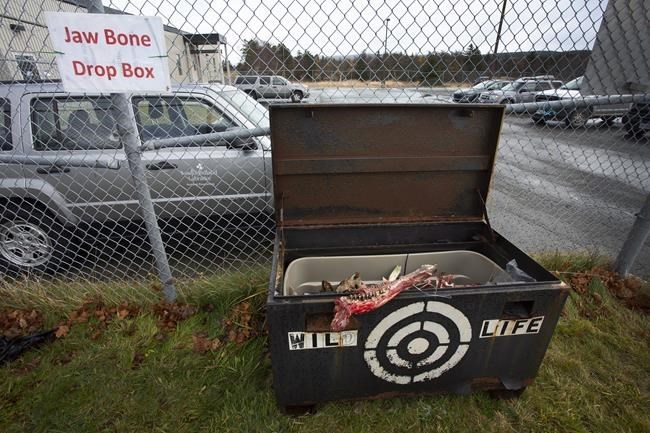ST. JOHN'S, N.L. — Fifty years of flesh-specked, festering jawbones pried out of moose by hunters and dropped in bins all over Newfoundland and Labrador have led to what biologist Don Keefe says is among the richest wildlife data sets in North America.
Keefe, an ecosystem management ecologist with the provincial government, said his team is expecting to measure, boil, pick apart and analyze more than 3,000 jaws from this year's drop-off program. And they're mostly looking forward to it.
"I mean, there can be some smells, I'm not gonna lie," he said in a recent interview from the western Newfoundland town of Corner Brook.
Keefe said he encourages hunters to scrape off as much flesh as possible before they part with the jawbones, and to please not wrap them in plastic, even if the bone's picked clean. "Plastic enhances bacterial growth," he said.
The government of Newfoundland and Labrador has run the jawbone collection program since 1966, asking hunters to detach the bones from any moose or caribou they kill during the annual hunt. The bones can be left, along with the hunting tag, in special jawbone drop boxes set up each year in strategic spots across the province.
There are more than 50 such boxes this year, from Labrador's north coast to just outside St. John's.
"I'm pretty sure is the largest data set in North America. There's, like, more than 170,000 entries into the database," Keefe said. "I've had people phone years later and say, 'I hunted a moose in 1998, do you know the age of it?' ... Most times, we actually can find that, because the database is really good."
The jawbones have a lot to say, mostly because of the teeth. Moose teeth develop a dark band each winter and scientists can count them like rings on a tree to determine how old the animal is. Teeth and the spaces between them are measured and compared with the age readings, which provides a snapshot of how quickly the animal was growing, he said. If some moose have teeth that are too small for their age, that could indicate they were in trouble, Keefe said. "It's a measure of health, basically."
From each jawbone, Keefe and his team will remove two central incisors, which are the teeth at the front of the mouth. One gets sent to a lab in the United States that prepares slides of the tooth material for the ring counting, and the other is archived.
All the information goes into the massive database that can be used to project populations and make mortality estimates, among other things, he said. The province is presently hammering out its moose management plan for the next five years, and Keefe said the database will play a central role in any related modelling.
But some moose hunters in the province say the government shouldn't be so quick to congratulate itself for the prized data set. Barry Fordham, a founding director with the Newfoundland Outdoor Heritage Coalition, a group representing hunters and outdoor enthusiasts, said there's a five-year gap in the numbers because the program was halted in 2016, only to be reinstated last year.
"That was only, we believe, because of our lobbying efforts," Fordham said in a recent interview. Many other hunters and hunter organizations were part of those efforts, he said.
There are about 117,000 moose on the island of Newfoundland alone, according to government estimates. That's more moose than there are people in St. John's and it works out to about one moose per square kilometre — the highest moose density in the country.
But hunters like Fordham worry the population is in decline, and he said the jawbone collection data is key to understanding what's really going on. Aerial surveys, he said, just don't capture the same detail as a look inside the mouth of a moose.
Hunters are proud to take part in the volunteer program, Fordham said, noting there's no cash incentive to do so. But hunters do get a special patch showing their co-operation with the program. Both he and Keefe said the patches are highly sought-after.
Fordham said he dropped off a jawbone last year.
What's perhaps less glamorous is yanking out the jawbones themselves. "Everybody has their own way of doing it," Fordham said. "Basically, you skin the fur back off the jawbone, you separate the tongue and you unhinge the jawbone plate, and then you pry it out."
"Nobody takes glory in doing it of course," he added. "It's just something that has to be done."
This report by The Canadian Press was first published Nov. 21, 2021.
Sarah Smellie, The Canadian Press




